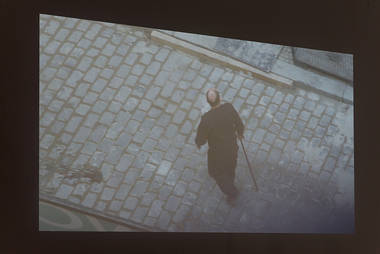Oskar Helcel: The Flow Building
4. 9. 2020 – 27. 9. 2020
opening: 3. 9. 2020 from 6PM
curator: Lenka Střeláková
The video-installation by Oskar Helcel in the Jeleni Gallery, consisting of three visual inputs separated from each other within the exhibition space during its approximately twenty-minute duration, gradually articulates and transcends the tension resulting from the interventions captured. The tempo and the actual composition of the moving images correspond to different types of confrontations undergone by the artist. These are linked by the subject of interest, i.e. a specific development project, and so antitheses naturally arise between the individual parts of this triptych too. For instance, between the smooth and interchangeable visualisation of the administrative complex and the views from the window over the rough building structure inhabited by the micro-stories of labourers. Or between the subjective camera that, in its unpleasant, shaky and confused proximity, is simultaneously alienated by the disturbing action, and the quietly distant, albeit still engrossed, oriented compositions. Between the silent, decisive intrusion into the space and bustle of a construction site and the questions timidly asked but never answered, which therefore gradually disperse into an autonomous narrative outside of the work itself.
Mr Woolf, you are the CEO and founder of the large development company Flow East. What does this name mean? Does it refer to the business flow from London to Prague, i.e. from West to East? – For almost 30 years of your life you have been investing in historical buildings and monuments. How did you feel about the fact that, in order to build your Flow Building, you had to demolish two historical buildings? – How does the illuminated facade of your building emitting a luminous smog comply with the ecologically sustainable concept of the Flow Building? – How do you feel about the fact that in a hundred years time an investor will arrive and buy up your plot of land, your Flow Building, and in murky collaboration with the state apparat will have it demolished and will not build anything in its place, but will leave it empty and will make no demands ensuing from ownership?
By following an ongoing cultural and political affair (the construction of the Flow Building on Wenceslas Square, which was preceded by the demolition of two listed buildings in Prague’s urban conservation zone despite the objections of experts) Oskar Helcel raises more general questions regarding the possibility of operating in a situation in which developers, working hand in glove in a dubious fashion with the state apparat and its administrative bodies, arrogantly and irrevocably change the urban character of the historical city centre.
The sequence of documents and rulings – a proposal for demolition, approval of said proposal for demolition, cancellation of said approval of the proposal for demolition, and cancellation of said cancellation of the approval of the proposal for demolition – testify to the intense and more or less undisguised special interest, informational, political and of course financial flows that converge in the foundations of a new administrative commercial building project. This familiar pattern of events is then joined by both the marching banners of the general and specialist public, and their reliable disarmament by calculated distortion. Incompetent ministers of culture, corrupt civil servants and the investor’s promise of a highly satisfactory cash flow at first sight humbly incorporating both the past and the future (i.e. the historical and environmental context).
However, the artist leaves a recapitulation of these recurring patterns, as well as an analysis of this particular affair, to professions more competent to carry out the task. Instead he approaches the situation with an awareness of his own strength, position and means of expression. The triptych thus symbolically gradually overlays the initial corporate visualisation as in a generic computer adventure, by appending other layers of reality and communication and correcting its deformed or absent perspectival anchorage.
The polished walls of the developer simulacrum, the vulgarity of its dimensioned correctness and transparency, form an impenetrable mirrored surface that then automatically and blindly reflects the circuits of externally guided communication: observation techniques, civic awareness or activism. But the illusion is not perfect, the architectural design does not disappear but in the end simply reveals something about itself in this its diffuse grimace.
Lenka Střeláková
(transl. Phil Jones)
The program of the Jeleni Gallery is possible through kind support of Ministry of Culture of the Czech Republic, Prague City Council, State Fund of Culture of the Czech Republic, City District Prague 7, GESTOR – The Union for the Protection of Authorship
Partners: Kostka stav
Media support: ArtMap, jlbjlt.net, UMA: You Make Art














